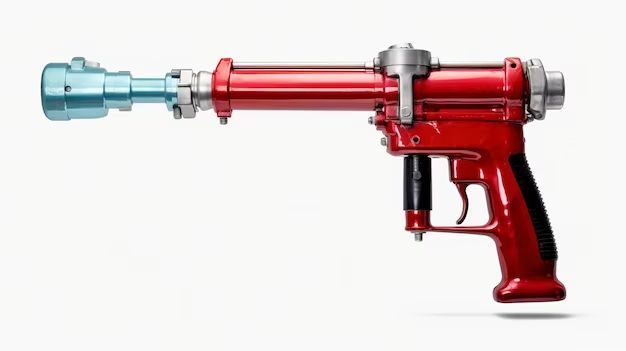Grease guns are important tools used to apply grease to mechanical equipment and machinery. The nozzle is a key component of a grease gun that attaches to the end and allows the grease to be applied precisely where needed. Understanding how the nozzle goes together and functions is useful for anyone who uses a grease gun regularly.
In this article, we will provide a detailed overview explaining how the nozzle of a grease gun is constructed and assembled. We will look at the different parts that make up the nozzle, how they connect, and how the nozzle attaches to the grease gun barrel. We will also discuss the different types of nozzles available and their specific purposes.
Page Contents
Grease Gun Nozzle Parts
The nozzle assembly on a typical grease gun consists of several main parts:
- Nozzle head – This is the very end of the nozzle that the grease exits from. It often has a conical or tapered shape.
- Nozzle tip – The tip screws into the nozzle head and has a small opening for the grease to pass through.
- Hose – A flexible rubber hose connects the nozzle tip to the nozzle head.
- Nipple – A nipple piece connects the hose to the nozzle head.
- Coupler – A threaded coupler connects the nipple and hose to the barrel of the grease gun.
The nozzle head, hose, nipple and coupler are usually made of metal materials. The nozzle tip may be metal or plastic. The rubber hose allows flexibility when applying grease. The nozzle tip opening size and shape can vary in order to control grease flow.
How the Nozzle Goes Together
Assembling the nozzle involves screwing the different components together in the proper sequence:
- The nozzle tip screws into the front of the nozzle head. The threads allow the tip to be tightened securely.
- The nipple piece then connects to the back of the nozzle head. It may thread in or use a quick-connect fitting.
- One end of the flexible rubber hose fits over the nipple. A clamp may secure it in place.
- The other end of the hose pushes over a standpipe on the coupler piece.
- The coupler threads onto the threaded end of the grease gun barrel.
When fully assembled, the grease can flow through the barrel, into the coupler, through the hose, out the nipple and then through the nozzle head and tip. The flexible hose section allows the nozzle to be bent to fit into tight spaces.
Attaching the Nozzle to the Grease Gun
Grease gun barrels will usually have a threaded male fitting at the end to which the nozzle attaches. Here are the steps to attach a standard nozzle:
- Make sure the grease gun is unloaded and the plunger fully down.
- Thread the coupler piece onto the end of the barrel. Tighten it securely by hand.
- Bend the hose on the nozzle assembly as needed to access hard to reach fittings.
- You can test the nozzle by briefly pumping grease. The grease should flow out the nozzle tip.
Always wipe off excess grease after using the grease gun. The nozzle can simply thread off for storage when not in use. Make sure to recap the nipple and nozzle tip to keep grease from hardening inside.
Types of Grease Gun Nozzles
There are different types of grease gun nozzles designed for various applications:
- Standard nozzles – These have a typical spout-shaped nozzle head and straight nipple. They work for most general greasing purposes.
- Flexible nozzles – Instead of a nipple and hose, these have a flexible rubber tube that connects directly to the nozzle head. This allows better bending.
- Needle nozzles – A needle nozzle has a very thin, long metal tube instead of a nipple and hose. This allows reaching into tight spaces.
- Specialty nozzles – There are specialty nozzles angled at 45 or 90 degrees. These are used to apply grease to hard to access fittings.
The nozzle tip shape and size can also vary between conical, flat, pointed, or bent. Different tips allow control over the grease flow pattern. It’s helpful to have a variety of nozzle configurations on hand to suit specific greasing jobs.
Maintaining the Grease Gun Nozzle
Proper maintenance will keep a grease gun nozzle functioning well:
- Always wipe off excess grease after use to prevent clogs.
- Store the nozzle with caps on to avoid grease drying inside.
- Check for cracked or worn hose sections and replace if needed.
- Make sure threads are not cross-threaded or worn.
- Use a needle or wire to clear any clogs in the nozzle opening.
- Replace bent needle nozzles to prevent improper grease flow.
With good maintenance and handling, a quality grease nozzle should provide years of reliable service.
Conclusion
In summary, a grease gun nozzle contains a nozzle head, nozzle tip, hose, nipple and coupler that all thread together to direct grease flow. The nozzle tip size and type can be chosen to suit the application. Nozzles screw onto the grease gun barrel and proper maintenance will keep everything flowing smoothly during use. Following these steps will allow anyone to assemble nozzles and use them effectively when greasing equipment. Proper nozzle selection and care is key to successful grease application.
